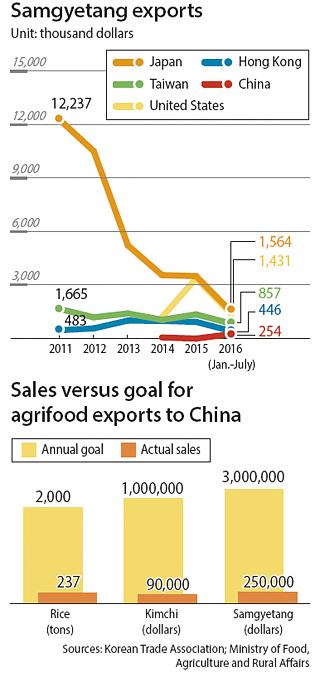Chinese have little taste for samgyetang

Sales of kimchi and rice exports during the year’s first half were sluggish as well, as the products sold just 10 percent of their annual goal. This raised questions about the agrifood export strategy to China at large.
More than 60 tons of samgyetang have been exported to China since its first shipping last June, according to industry insiders and the Korean Trade Association. The traditional Korean dish was exported in pouches produced by government-appointed companies Halim, Nonghyup Moguchon, Sajofine Korea, Gyodong Food and Chamfre and sold in China’s supermarkets and online shopping malls.
Although the exports are still in the early stages, the overall response is that export volume is below expectations. Earlier this year, the government said that it had opened ways to export samgyetang to China, resolving non-tariff barriers such as quarantines that were hindering its entry.
The Korea-China summit last year suddenly opened China’s doors to samgyetang. “This allowed the government and relevant companies to start exports as fast as May - without being fully prepared,” said Kim Han-ho, professor for Agricultural Economics and Rural Development at Seoul National University.
Before China, the main target for exports was Japan. Samgyetang exports reached their peak in 2011, posting a yearly revenue of $14.7 million, the Korean Trade Association said. However, exports were cut in half in 2014 as sales in Japan - which made up 70 percent of samgyetang exports - fell. Japan’s weakened yen and cooled relationship with Korea brought down sales.
The Ministry of Agriculture, Food and Rural Affairs and domestic companies set their eyes on China as the next market for samgyetang exports.
The reason behind sluggish sales is said to be the failure in localizing the dish to China’s taste and food culture. For example, ready-to-eat food has a low credibility among Chinese people who prefer larger sizes of chicken than those used in samgyetang, which traditionally uses young poultry. Critics say the dish should have been promoted along with Korean food culture.
Industry insiders warn that the samgyetang export industry should learn from the failures of kimchi and rice exports, which also have declined since their first shipping in December and January. The government exported 237 tons of rice in the first six months, far from its yearly goal of 2,000 tons. Kimchi failed to exceed 10 percent of the export goal during the year’s first half.
Industry specialists say insufficient market research, difficulties in finding local buyers and low popularity were reasons behind Korea’s failure of food exports to China.
The immediate task is to open distribution networks by establishing relationships with local partners that supply for China’s middle-class. “Instead of setting marketing strategy for Chinese people in general, it would be better to hire a local buyer and make way for a distribution channel in the country’s middle and high-class market,” said Kim.
Samgyetang providers should avoid the cutthroat competition among domestic manufacturers, which pulled down kimchi and samgyetang sales in Japan, insiders say. In the case of kimchi, several providers excessively cut prices, consequently sending kimchi exports down from $86.8 million in 2011 to $44.5 million in 2015.
To push sales, the government and domestic companies will install promotion centers in areas such as Beijing and Shanghai. “Advertisements and a documentary on samgyetang are also under preparation,” said an official with the agriculture ministry.
BY CHO DEUK-JIN [song.kyoungson@joongang.co.kr]










with the Korea JoongAng Daily
To write comments, please log in to one of the accounts.
Standards Board Policy (0/250자)